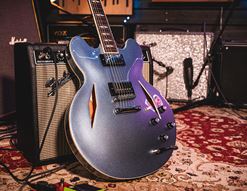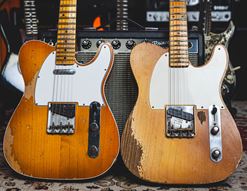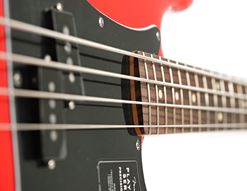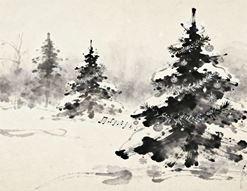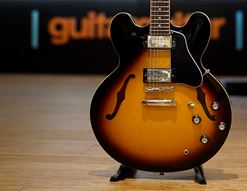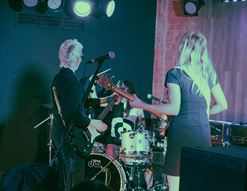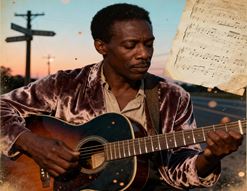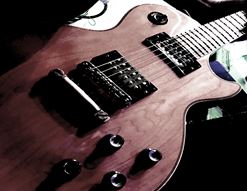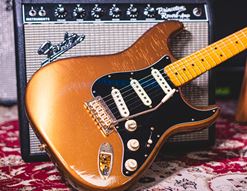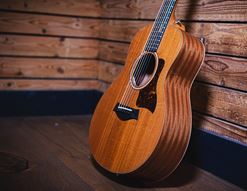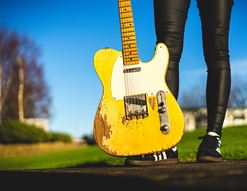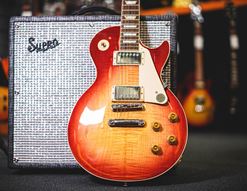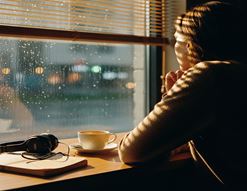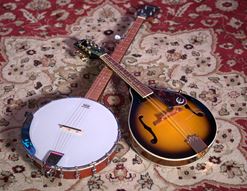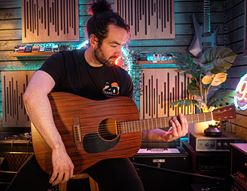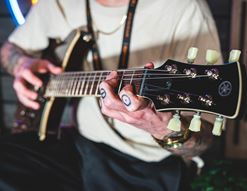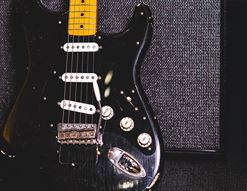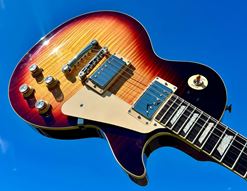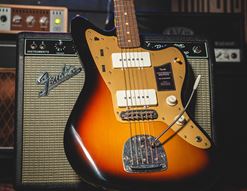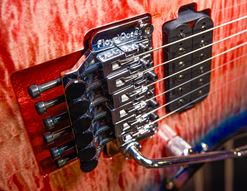Are you a U2 fan? If so, you probably love the angular, expressive guitar sounds made by their iconic guitarist The Edge. If you’re not a fan, I have a feeling you’ll probably still enjoy learning some details about Edge’s sound, right? After all, how many people sound or play like him?
Nobody plays like The Edge: he has a truly unique style, and one that’s instantly recognisable. Never one to dominate in terms of traditional leads, he instead prefers to weave shards of bespoke sound around the songs, framing and colouring them in his own inimitable way. You can hear Edge’s influence in many players, but he still stands unique in a world of ‘same-old, same-old’ guitarists.
Today, I want to explore Edge’s sounds with you, and his approach to guitar playing. Because U2 have had such a long career, I’m actually going to divide it into three parts: early days, the Joshua Tree era (and round about it) and the Achtung Baby/Zooropa era that came afterwards. That still only brings me to the mid-90s, but I’d maybe venture that the lessons learned from these distinct points in time will be enough to cover what Edge has done since. From the millennium onwards, I feel that U2 have - sonically at least - allowed themselves to look backwards and pick up threads from their earlier work, so I don’t feel much need to cover latter period music.
What this is is a celebratory dive into a unique, interesting and popular musician. What it’s not is a trainspotter’s guide to every single note the guy played and pedal that he used. We’re taking an overview tour of some of his great sounds, and discussing how you can recreate some of that sound and inspiration.
Are you up for it? Let’s do this!
Contents
Even Better Than the Real Thing
How to Play Guitar Like The Edge
Get a Guitar Pick With An ‘Edge’
Early Edge
U2 came around during the post-punk explosion of energy that occurred in the late 70s. I don’t think anyone would necessarily describe them as a ‘post-punk band’ per se, but those early records - Boy, October and War - definitely have an urgent energy. There’s a lot of sonic invention and ambition too, and as the sole guitarist, The Edge has a lot to do with that. I’ll talk about his playing style later on in a separate section, but for right now, let’s look over the equipment he used in those early years.
Gibson Explorer
In his autobiography, Bono famously referred to Edge as having a guitar that looked like his face. Given that the guitar was a Gibson Explorer, that’s a complicated statement indeed! Anyway, Edge got his Explorer - a natural ‘Korina’ 1976 example - during a family holiday to New York in ‘78. This is the guitar you hear on Boy, October and War primarily, and then sporadically throughout his career.
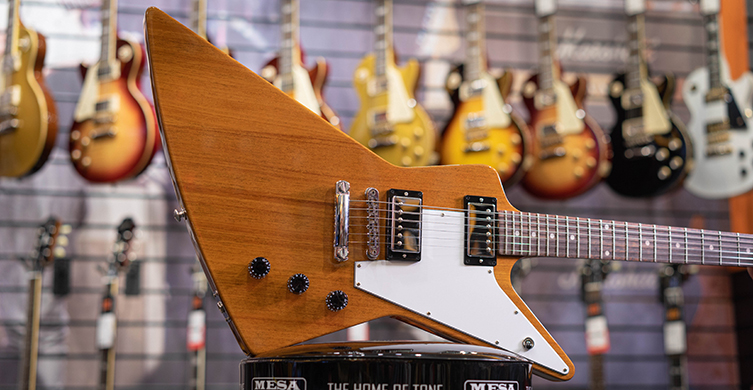
The Explorer has a thick sustaining tone that I’d say isn’t necessarily what one thinks of for The Edge. Still, listen back to those early records and it’s an unmistakably ‘Gibson’ sound.
Vox AC30
Edge’s love of Vox amps has been one constant of his guitar playing life. From the earliest shows to the enormous international tours U2 are famed for, Edge has always had an AC30 on stage with him. He has a number of them, though one in particular seems to be his favourite. You can tell it by looking at his amps: it’s by far the most beaten-up thing on stage!
From my research, it seems that he uses the normal channel (not the Top Boost channel) and has a pretty loud onstage volume. The idea is to get that ‘edge of breakup’ sound, where there’s still chime and cut, but some added grit in there, too.
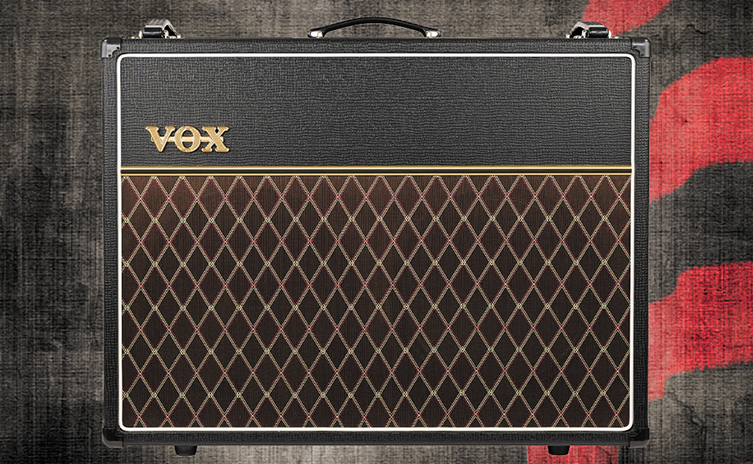
Electro-Harmonix Deluxe Memory Man
Delay effects have always been a thing for Edge. They became more complex as his career progressed, but even at the start, Edge implemented delays into his primary guitar sound. The Electro-Harmonix Deluxe Memory Man provided him with space and atmosphere, which, for the sole guitarist, was an extremely important element in his sound.
Back at the start, it was less about using delay in rhythmic ways, but check out a song like Electric Co and you’ll hear him rhythmically reacting to the delay pedal.
Joshua Edge
Next I’ll move onto the records that more or less defined Edge’s sound, at least in a ‘shorthand’ way. 1985’s The Unforgettable Fire and 1987’s Joshua Tree records are the ones to study if you want that famously rhythmic Edge sound. This was when he began using delays in a very pronounced way that dictated his playing as well as informing his approach. We hear jangly yet strong rhythm parts, while his patented ‘dotted delay sound’ added layers of depth and drama to the music.
There are some key songs to check out, which I’ll thread throughout this section. Now, let’s talk about the gear!
Fender Stratocaster
Now, I don’t want to be flippant here, but I don’t think it’s massively important which type of Stratocaster you choose when going for Edge’s sound. It seems that the black Strat that Edge used from the War tour onwards was/is a 1973 model, and apparently hasn’t been modded. This guitar is NOT the black Strat you’ll have seen Edge play in recent years, to my reckoning. Let’s face it: he probably has loads of Strats - including his own signature model from a few years back - because he’s on the board of directors at Fender!
Anyway, Edge’s tech Dallas Shoo is well known for tinkering with his guitars, so whilst there are no ‘mods’, that doesn’t mean the pickups haven’t been rewound etc. Some of Edge’s Strats seem to have brass bridge saddles, so by all means look into that for more sustain and maybe resonance. Otherwise, it’s pickup position 2 (bridge and middle), gauge 10 strings and a regular Stratocaster, really.
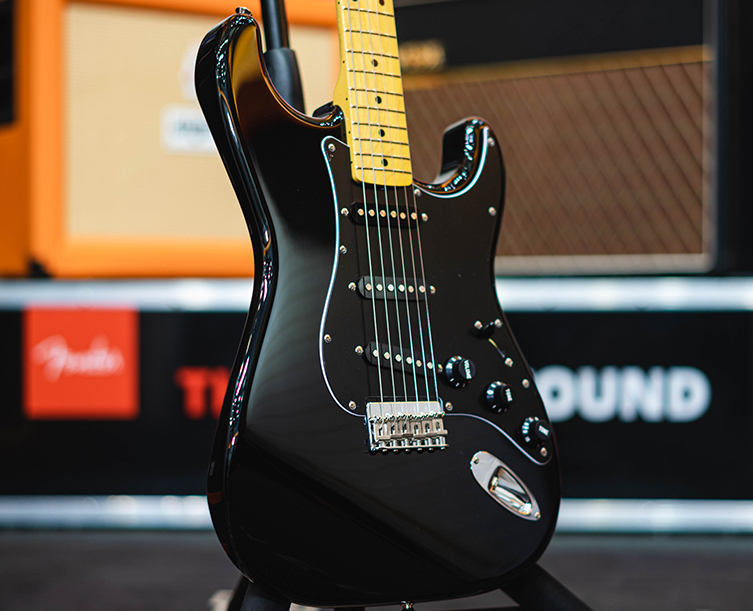
Korg SDD-3000 Digital Delay
This Korg digital delay is perhaps the most important element in Edge’s tone. Listen to A Sort of Homecoming, Pride (In the Name of Love) and Bad, all from the Unforgettable Fire album. These are all masterful examples of Edge’s trademark dotted delay method, which utilises one and often more than one of his rack mounted delays (he had three in his rack!) to not only get a stereo sound with different levels of input gain, but to line up the delay tempos in order to achieve the famous dotted 8th note delay sound.
The Famous Edge Dotted Delay
Since you are reading this guide, I can say with certainty that you want to get Edge’s delay sound, right?
Many delay pedals will have a specific setting for dotted 1.8ths these days, so look out for that on your own delay pedal! If not, you basically want two delay lines going at once: one landing on the beat and one 3/16ths of the way there. This basically falls in between the gaps of the on-the-beat 8th notes, and gives it that full, rhythmic sound. If you play along with the beat, that extra 3/16th line will give you the illusion of playing 16th notes, which is Edge’s magical sound!
Handily, my colleague and I checked out the MXR Joshua delay a while back, so have a look at this video for some examples on getting this sound.
Other Elements
I’m simplifying a little here for the sake of a straightforward read, but Edge had a fair number of units in his rack at this time, and they maybe aren’t too obvious to the ear, upon a casual listen at least. In addition to the Korg delays, there was also the following:
- Electro-Harmonix Memory Man
- Yamaha R1000 Digital Reverb
- Yamaha D1500 MIDI Digital Delay
- MXR Pitch Transposer
- BOSS SCC-700 Effects Controller
He also utilised a few additional guitars back then:
- 1975 Les Paul Custom (we’ll hear more of this one)
- 1970s Telecaster Custom
- 1960s Gretsch White Falcon, rewired from stereo to mono
A selection of keyboards were used too, including a Yamaha DX-7, CP70 and Oberheim OB-8.
The Infinite Guitar
The song With or Without You has a lot of subtle guitar parts, and one is a melodic, sustaining part similar to what perhaps a violin would do. This part, which plays throughout the song, was performed on an invention called ‘the infinite guitar’. Developed by experimental guitarist Michael Brook, the Infinite guitar is a modified Strat with a circuit that took the guitar signal from the pickup, amplified it more and sent it back into another pickup. It creates a sort of predictable feedback loop of your fundamental note and certain sympathetic harmonies.
This sound apparently saved the song from being duped on the scrap heap! Hard to believe when it’s now regarded as one of U2’s best songs. Live, Edge tends to play this part with a Sustainer pickup in his guitar.
Achtung-Era Edge
I’ll now shift across to U2’s 1991 watershed album, Achtung Baby. This album saw a revitalised and experimental Edge, who was channelling a range of intense emotions into his playing. We hear lots of distortion, slide playing and ‘clouds’ of guitar that sound almost like the shoegaze music that was prominent then. U2 had obviously been paying attention to the outside world, and the result was a multi-faceted record. There’s loads of invention on Achtung Baby, and a large palette of sounds, so I’ll choose a few examples to highlight.
First, though: the gear!
Achtung Guitars
More than possibly any other era of U2, the Achtung Baby/Zooropa/Zoo TV time saw Edge using a wide variety of guitars. Interestingly, it seems that the Explorer was shelved for a time, but he made up for it with an enviable selection of axes. Check this out for a list…
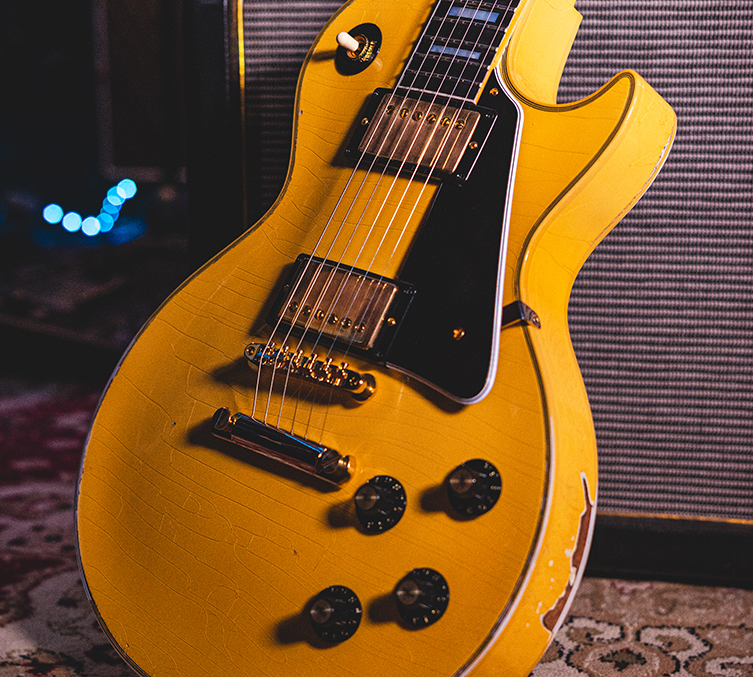
- 1975 Gibson Les Paul Custom in Cream (speculation exists that it was originally white and has aged to cream) with T-Top pickups (not shown above)
- 1972 Gibson Les Paul Custom in Ebony
- Fender Custom Shop Strat - Purple with skeleton and snake decal/graphic and Lace Sensor pickups (I reckon this is actually an Eric Clapton signature model)
- Rickenbacker 330 in Fireglo
- Black Strat (I cannot figure if this is a new one or a ‘classic Edge’ Strat, as I mentioned previously!)
- Gibson ES-330 Tobacco Sunburst
Slightly later periods saw Edge using Gretsch hollowbodies (PopMart era) and Telecasters (early 2000s), alongside the return of the Explorer and the constant presence of Strats.
Achtung Amps
The omnipresent AC30 continued to be a force in Edge’s tone, though now he had a wall of them, and supplemented them with one or more vintage Fender Deluxe combos. It seems that a blend of a number of mic’d amps is what achieved Edge’s base tone throughout recording and during the ZOOTV tour.
Even Better Than the Real Thing
This hit song crams in lots of colourful guitar parts. First off is the intro, which uses a Digitech Whammy pedal (some say 2 octaves up, I think one up sounds more like it) along with overdrive and delay. Simple enough, but there’s also an extended slide guitar solo later on in the song which is unusual for The Edge. He’s never been an ‘anti-solo’ player at all (New Years Day, anyone?), but he doesn’t generally take the spotlight quite like he does here. Throughout their career, slide playing has been a feature in U2’s music, and Edge is a very melodic and precise player. No blues licks!
Mysterious Ways
One of the ‘secret weapons’ of Achtung Baby in terms of guitar gear is an effects unit called a Korg A3. Truly, it's a bit of a revelation to play through the appropriate presets and see just how ‘there’ the sounds already are! Now, I’m not saying that the Edge is a preset guy, not by a long shot, but that amazing and unusual tone that you hear throughout Mysterious Ways is VERY hard to achieve without a certain Korg A5 preset (no 75)!
Most of us don’t have one of those 35 year old rackmounted effects units though, so from what I can gather, that sound is a combination of distortion, wah (an auto wah), an exciter (EQ, really), delay, flanger (yes, after the delay) and a plate reverb.
Quite a list! This is one of those situations where trying to dial up that specific tone may or may not bring you results, but you’ll almost certainly land on something interesting!
The Fly
I will happily admit that the guitar sound on The Fly is a real favourite of mine. It has lots of movement and character, with a ton of atmospheric ambience too. It’s distorted, there is a wah, some degree of modulation and then the reverb and delay.
Still, it’s not an easy tone to duplicate, even for the Edge himself: check out any live renditions of the song and you’ll hear a markedly different sound. So what’s the deal here?
After years of wondering, I did finally read something that shed a little light on the process. Apparently, the song was recorded, mixed and then re-mixed again and again, trying to get the right feel. Once it was ‘done’ and mastered, Edge decided that his guitar didn’t stand out enough at certain parts (notably the intro), so he actually went back in and recorded another guitar part directly on top of the mastered audio! Tell that to any audio engineer and they will freak out and start swearing at you, but the results speak for themselves! It’s an absolutely awesome guitar sound, and Edge must’ve been super tight with his timing because it sounds genuinely like one performance.
Also, GREAT guitar solo!
Fast-Forward to The Sphere
Now, as I mentioned earlier, I feel that after Pop (which has a load of great guitar sounds but I don’t have space for it), U2 deliberately returned to their classic sound, which I’ve already covered. It's a great sound but there are no real surprises to report to you about The Edge’s guitar work.
That is, until they played their residency at The Sphere in Las Vegas and Edge went ENTIRELY DIGITAL!!! After decades of humphing heavy tube amps around the planet, he finally decided to go amp-less. Now, this is because The Sphere is no regular venue nor is its stage a normal one. Check out the footage for yourself and you’ll see what I mean in terms of backline and so on. So, what he used instead was a brace of Universal Audio digital modelling pedals. Here’s what he said, courtesy of Guitar World:
“For various reasons at the Sphere I decided to switch from amplifiers to digital amp emulators. I'm using UA Ruby, Dream and Woodrow amp pedals with some Fractal Axe-Fx units handling additional amp emulation and FX. When you introduce radio leads and all the electronics involved it's never the same as a simple guitar into amp tone, so it's a case of high-level complexity to make it sound simple.”
If it’s good enough for U2 at The Sphere, I reckon there’s not much else you can say about that! For reference, here are the amps that each UAFX pedal is emulating:
- UAFX Woodrow: 1955 Fender Deluxe Tweed
- UAFX Ruby: 1963 Vox AC30 Top Boost
- UAFX Dream: 1965 Fender Deluxe Reverb
So, he stuck largely to what he already knew he liked for amps. It would be interesting to know what the Fractal was doing in terms of amp emulation, but that info isn’t anywhere I can find.
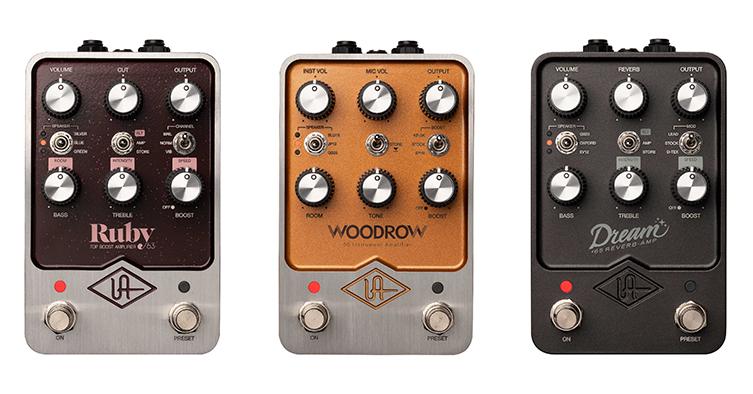
So, that’s my guide to Edge’s equipment, with some insights into particular tones and sounds. Now, I’ll finish up by discussing some ways in which you can get closer to his playing style.
How to Play Guitar Like The Edge
These pointers and tips come from my own interest in how Edge approached his guitar parts, and from research I’ve looked into over the years. He’s certainly a unique player, but a lot of what he actually does is pretty straightforward; it’s the application of it that makes it effective. See how you get on with these…
Get a Guitar Pick With An ‘Edge’
Sorry for the pun, but this is actually a huge part of Edge’s sound. He uses one pick and one pick only. You want a blue Herdim pick, made in Germany, .88mm in thickness and made from nylon. The reason these are special is the extended grip area that extends to the edge of the pick. Edge holds his pick ‘upside down’ and gets the textured edge (stop it) to hit the strings, resulting in a very recognisable sound.
These picks can be tricky to source and expensive, so I’ve found similar levels of success with Herco picks, and certain Acoustik Attak picks.
Dodge the Blues
Looking at U2’s body of work, it’s actually very difficult to land on any examples of guitar playing that make overt use of the blues scale. He once said it himself: “My ear has never found much solace in the blues scale”, and even if it has crept through a little in later period stuff, his music for the most part dodges it.
Edge, therefore, is a great player to check out if you want to play melodic parts that don’t follow those time-worn box shapes on the fingerboard. The solos that I’ve already mentioned in this blog would be great places to start, but also listen to the incendiary sounds on Love is Blindness (there are two distinct parts you’ll want to know about here) for a bit of a gauntlet throw-down from him
Arpeggios & Arpeggio Riffs
Where The Streets Have No Name is the obvious one, but loads of Edge’s music uses partial arpeggios - with frequent back and forth between octave root and fifth notes - to add glitter to the songs. Listen to Heartland, from Rattle & Hum, check out the ‘give yourself away’ section from With or Without You, and for a supreme example, stick on his incredible solo from All I Want is You, also from Rattle and Hum.
Why didn’t I put this one in the ‘Dodge the Blues’ section?
Use ‘Middle-Pitch’ Notes
Edge seems to like playing around the centre of the fingerboard. Obviously, there are plenty of examples where he goes low and high, but that area between, say, fret 7 and 12 sees a LOT of action. I wonder whether it’s intentional or simply what he likes hearing, but his parts are very good at staying out of his band members’ sonic space. This allows bassist Adam Clayton room to express on the low end, and vocalist Bono to access the full range of his voice. Edge is very ‘there’ without having to force his point across, and that’s a pretty excellent trick to learn.
Hold Back
He’s the only guitarist in the band (no offence, Bono), but he frequently pulls back on the notes and the volume. There is something massive about NOT playing, and more guitarists need to learn this! Let me use two huge U2 songs as examples…
Where the Streets Have No Name has one of his most famous guitar riffs (see earlier), but after that, what is he up to during the verses? Very little except for some rhythmic mutes. The odd tickle of a chord to emphasise a change. Not much at all, and it’s AMAZINGLY effective. He doesn’t lean in: he steps back, and that makes him all the more effective when the chorus comes.
My other example is With or Without You. The whole song is a masterclass in tension and release, from each band member. Now, once the big crescendo of the song hits, check out what The Edge plays. A huge, blistering epic howl of a solo? No. He goes for a quietly elegiac, mournful response to the sadness of the lyric, a massive example of underplaying the drama. If it was me, I would’ve gone for the spotlight, and probably ruined the tune! The restraint shown here is a wonderful example of his sensibilities, and that’s what makes him the player he is.
Learn to Play the Effects
Effects are obviously integral to Edge’s approach. It’s not a matter of writing something and then maybe adding a smear of chorus in post-production: for the Edge, effects are often the reason a guitar part is what it is.
The delay stuff hopefully speaks for itself in this regard, but there are loads of other examples where an effect suggests the part to him. The Zooropa record is rich with examples of this type of ‘sound design guitar playing’. Lemon has a very synthy, tremolo guitar part that is almost not a guitar; Numb has a heavily distorted flanger taking most of the guitar’s actual pitch away; and my favourite is the title track itself. Zooropa has a guitar part that is so out-of-the-box that it can actually pass you by a little. It’s an immense sound - you’ll know exactly which sound I’m talking about when you hear it - but it’s only when you learn which notes are actually being played and which aren’t that you’ll realise the genius of it.
My point here is that it isn't a case of being good at playing the guitar: it’s about hearing possibilities, working on them, focusing on the eccentricities of it, and pushing those parts forward, instead of generic ‘good guitar playing’.
The Edge - The Idea is King
What seems to be the case here with The Edge is that he’s a chaser of ideas. It’s almost like the method is less important than the end result, and that sometimes, the equipment is a problem to be resolved in order to get to the goal.
I’m happy to call him an impressionistic player, or a cinematic player, but I think those only cover some of the truth. He’s actually a very direct guitarist, hugely so, in fact. His use of atmosphere might actually lead us to believe otherwise, but his ability to hold back (the best lesson of all to learn, really) has as direct an effect on the song as when his careful orchestrations crash in. He wears a lot of musical hats, but they are all very strongly ‘him’.
If that’s not the mark of a great musician, then I don’t know what is! Here’s to The Edge: no matter how famous U2 are, he’s an underrated master of the guitar.

